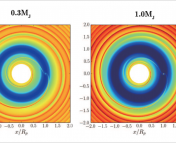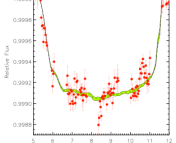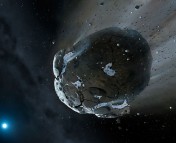- Title: Counter-orbiting Planets Were Flipped Over by a Coplanar Outer Object
- Authors: Gongjie Li, Smadar Naoz, Bence Kocsis, Abraham Loeb
- First Author’s Institution: Harvard
- Paper Status: Submitted to Nature
Some large, close-in planets, “hot Jupiters“, orbit in the opposite direction of their host stars’ spins. Actually quite a few; this paper reports as many as one in four.
That’s nice.
Nice!? No! No, no, wait! That’s not nice, that’s insane! Consider that planets and their host stars form together from a large disk of interstellar gas and dust. We expect that objects formed from a single rotating disk are all going to orbit in the same general direction. This is how it works in our backyard: all the major objects in our solar system orbit counter-clockwise if you’re looking down from the northern pole. So how do so many hot Jupiters come to orbit backwards?
These authors propose a mechanism for orbit flip. A third outer companion (another Jupiter-sized planet, or a small companion star) perturbs the orbit of the inner planet into a long, stretched-out ellipse, little by little by little, until bam!, all at once, the orbit flips over its major axis. The sudden orbit flip happens because the inner planet has been slowly losing angular momentum (picked up by the outer companion); in this process its round orbit is transformed into a long out-and-back orbit. When the planet’s angular momentum is vanishingly small (it’s basically on a collision course with its host star), it only takes a slight gravitational kick from the outer companion to switch the direction of its orbit.
This video (lifted from the lead author’s website) shows the inner planet’s orbit as its shape and direction get perturbed by the outer companion. The planet orbits many thousands of times in this one video, so instead of showing the planet, the video simply shows a hoop representing its current orbital trajectory. The coloring of the hoop corresponds to the phase of the orbit. The black arrow represents the direction of the inner planet’s orbital angular momentum, and the pink arrow represents the amount of that angular momentum projected in the up- or down-direction.
(A note: the orbit hoop precesses first from right to left across the back, then from left to right across the back. Another note: the outer companion orbits in the x-y plane much further out, at about 50 AU, whereas the inner orbit is several AU. One more note: the length of the black arrow is fixed to emphasize direction rather than magnitude.)
You can see the pink arrow get shorter and shorter, this is the angular momentum getting transferred to the outer companion little by little. Halfway through, the direction of the angular momentum (the black arrow) flips from +z to -z, just as the the hoop gets very elongated. This is the orbit flip.
Now this is not the first explanation proposed for hot Jupiters with flipped orbits. We’ve reviewed several other proposals here at astrobites. In fact, in a previous article these authors propose the Kozai mechanism, which is often invoked to explain highly-eccentric exoplanet orbits. But as they point out, this requires that the orbital planes of the inner and outer bodies be highly inclined to start with–and that’s not a likely configuration.
What’s interesting about this new proposal is that the initial configuration is coplanar: the inner planet and the outer perturber are born orbitting in the same plane. It does require a high initial eccentricity for both the inner and outer bodies, but this may be a common starting point for planetary systems.
Could this mechanism be the dominant cause of hot Jupiters orbiting backwards? The authors pose an observational question to test their theory: “how many hot Jupiters have highly-eccentric outer companions?” (A chorus of astronomers reply: “We’re on it!“)
Note: Thanks to one of NASA’s fine artists for the painting of the hot Jupiter on the front page. And apologies for my red scribbles across its surface.




